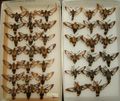- Hemaris
-
Hemaris Hemaris diffinis
Lake Junaluska, North CarolinaScientific classification Kingdom: Animalia Phylum: Arthropoda Class: Insecta Order: Lepidoptera Family: Sphingidae Genus: Hemaris
Dalman, 1816species See Text
Synonyms - Aege R. Felder, 1874
- Chamaesesia Grote, 1873
- Cochrania Tutt, 1902
- Eitschbergera Kemal & Koçak, 2005
- Haemorrhagia Grote & Robinson, 1865
- Hemaria Billberg, 1820
- Saundersia Eitschberger, Danner & Surholt, 1998
- Mandarina Eitschberger, Danner & Surholt, 1998
- Jilinga Eitschberger, Danner & Surholt, 1998
Hemaris is a Holarctic genus of sphinx moths, consisting of about 17 species living in the Holarctic[1], four of which fly in North and South America, three fly in Europe.[2] Their main host plants are herbs and shrubs of the Dipsacaceae (Teasel) and Caprifoliaceae (Honeysuckle) families. Moths in the Hemaris genus are collectively called Clearwing Moths or Hummingbird Moths in the US, and Bee Hawk-Moths in Britain.
Contents
Form
Eggs are small, spherical, and pale glossy green in color.
The larvae are small, cylindrical, and granulose. The granules often have small bristles. While most larvae are green and brown, many color forms exist. All have a distinctive pale dorso-lateral longitudinal stripe from head to horn.
Pupae are enclosed in a loosely spun cocoon, and are glossy in most species. There is a prominent tubercle, or hook, alongside each eye. The cremaster is large, and flattened.
The imagos, or adults, are small, diurnal moths that resemble bumblebees in shape. They are often mistaken for hummingbirds, which is why their common name is hummingbird moths. The forewings have hyaline areas or are fully scaled. The species with hyaline areas are initially with covered scales, but these are shed during their first flight. The antennae are strongly clubbed in both sexes, with a small recurved hook at the end. The abdomen ends in a large fan-tail of setae which resembles a lobster tail.
The genitalia of the male are asymmetrical, having the uncus divided and the two lobes subequal, heavily sclerotized with a rounded apex. The ostium bursae of the female is angled to the left.
Species
- Hemaris affinis - (Bremer 1861)
- Hemaris aksana - (Le Cerf 1923)
- Hemaris alaiana - (Rothschild & Jordan, 1903)
- Hemaris beresowskii - Alpheraky 1897
- Hemaris croatica - (Esper 1800)
- Hemaris dentata - (Staudinger 1887)
- Hemaris diffinis - (Boisduval 1836)
- Hemaris ducalis - (Staudinger 1887)
- Hemaris fuciformis - (Linnaeus 1758)
- Hemaris galunae - Eitschberger, Müller & Kravchenko, 2005
- Hemaris gracilis - (Grote & Robinson 1865)
- Hemaris molli - Eitschberger, Müller & Kravchenko, 2005
- Hemaris ottonis - Rothschild & Jordan 1903
- Hemaris radians - (Walker 1856)
- Hemaris rubra - Hampson 1893
- Hemaris saldaitisi - Eitschberger, Danner & Surholt, 1998
- Hemaris saundersii - (Walker 1856)
- Hemaris staudingeri - Leech 1890
- Hemaris syra - (Daniel 1939)
- Hemaris thetis - Boisduval, 1855
- Hemaris thysbe - (Fabricius 1775)
- Hemaris tityus - (Linnaeus 1758)
- Hemaris venata - Felder 1861
Gallery
-
Hemaris diffinis variation
-
Hemaris thysbe or Hummingbird Clearwing
-
Hemaris thysbe Hummingbird Clearwing Moth
References
- ^ Ian J. Kitching, Jean-Marie Cadiou: Hawkmoths of the World. An Annotated and Illustrated Revisionary Checklist (Lepidoptera: Sphingidae). Cornell University Press, New York 2000, ISBN 0-8014-3734-2
- ^ Fauna Europaea Hemaris Dalman 1816
Categories:
Wikimedia Foundation. 2010.






